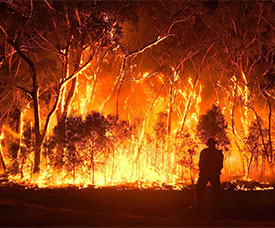We just had the world’s hottest day on record, initial data shows — and experts say it’s only going to get hotter
(ABC News) – Scientists told us it was close.
And now we have data suggesting that on Monday, the record for the hottest day ever globally was broken.
The average global temperature on July 3 hit 17.01 degrees Celsius, according to data from the US National Centers for Environmental Prediction (NCEP), topping the previous August 2016 record of 16.92 degrees.
“This is not a milestone we should be celebrating — it’s a death sentence for people and ecosystems,” said climate scientist Friederike Otto, of Imperial College London’s Grantham Institute for Climate Change and the Environment.
 |
| Australia is looking down the barrel of a hot, dry summer — and that means an increased likelihood of bushfires. |
The news, while concerning, isn’t exactly a surprise, with other heat records falling and climate disasters increasingly wreaking havoc across the globe.
The World Meteorological Organization — the United Nations (UN) agency specialising in climate and weather — on Tuesday declared the 2023 El Niño underway, which could see more temperature records tumble over the next 12 months.
“Worryingly, [July 3, 2023] won’t be the hottest day for a long time,” ProfessorOtto said.
The data is based on analysis of NCEP figures by scientists at the University of Maine’s Climate Change Institute, and was compiled from a range of land and sea observations from across the world.
The hottest day “record” remains unofficial, having yet to be corroborated by other measurements.
But Ailie Gallant, an associate professor at Monash University School of Earth, Atmosphere and Environment, said whether Monday really was a record-breaker ultimately didn’t matter. “The point is that we are getting a lot more of these very hot days. We’re getting a lot more heat waves and ... elevated temperatures,” she said.
“This is the new norm. We will continue to get hotter and hotter weather until greenhouse gas emissions are abated and we start to turn around climate change.”
Many countries across the globe are sweltering through heatwaves.
Temperatures in China have been pushing above 35C, while northern African nations have been suffering under 50C heat.
Southern parts of the US have been baking, while Antarctica (which is currently in winter) has also registered above average temperatures.
“It’s just happening everywhere,” Melbourne Climate Futures deputy director Kathryn Bowen told ABC Radio Melbourne.
“These records will just continue to be broken and so it’s really now time to look at these with the urgency that it demands to make sure that we’re developing the solutions and the responses that make sense to everyone.”
In May, the UN warned global temperatures were set to break records in the next five years, with a 98 per cent chance of one being the warmest ever recorded.
The warmest 10 years on record have all happened since 2005, which scientists say is largely due to climate change caused by human activity.
Rapidly increasing global temperatures combined with an El Niño would be bad news for Australia over the next 12 months.
The Bureau of Meteorology is yet to formally pull the trigger on an El Niño declaration, holding its status at one level below a full declaration, as it has different criteria to overseas agencies.
An El Niño would supercharge an already volatile and warming climate in Australia, Professor Bowen said.
“We’re going to be looking at potentially a much hotter and drier summer,” she said.
That means increased risk of drought, heatwaves, bushfires and coral bleaching.
“The widespread heat in the northern hemisphere hasn’t fully reached us yet in the Southern hemisphere, but over the coming years, it will as our massive oceans gradually warm up,” said Steven Sherwood, a professor at the UNSW Climate Change Research Centre.
(Latest Update July 6, 2023)
|